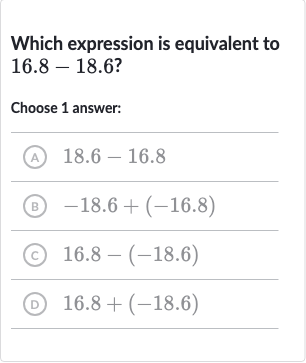Full solution
Q. Which expression is equivalent to ?Choose answer:(A) (B) (C) (D)
- Perform Subtraction: We need to find an expression that is equivalent to the subtraction of two numbers, and . Let's start by performing the subtraction to understand what we are looking for.We are looking for an expression that also results in .
- Evaluate Option (A): Let's evaluate option (A) . This is not equivalent to , so option (A) is not correct.
- Evaluate Option (B): Now let's evaluate option (B) .This is not equivalent to , so option (B) is not correct.
- Evaluate Option (C): Next, let's evaluate option (C) . This is not equivalent to , so option (C) is not correct.
- Evaluate Option (D): Finally, let's evaluate option (D) . This is equivalent to the original expression , so option (D) is correct.
More problems from Composition of linear and quadratic functions: find a value
QuestionGet tutor help
QuestionGet tutor help
QuestionGet tutor help
QuestionGet tutor help
QuestionGet tutor help

